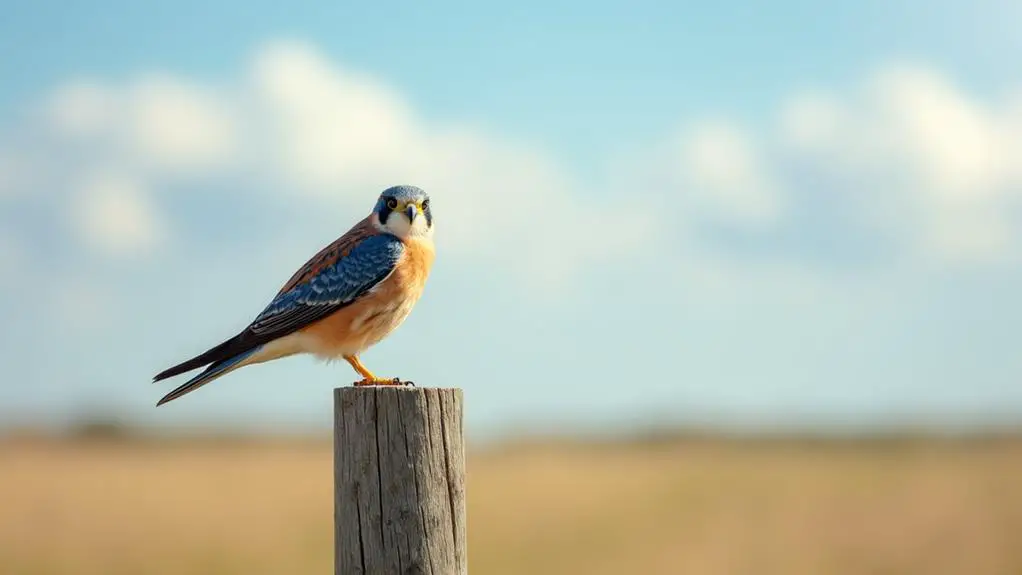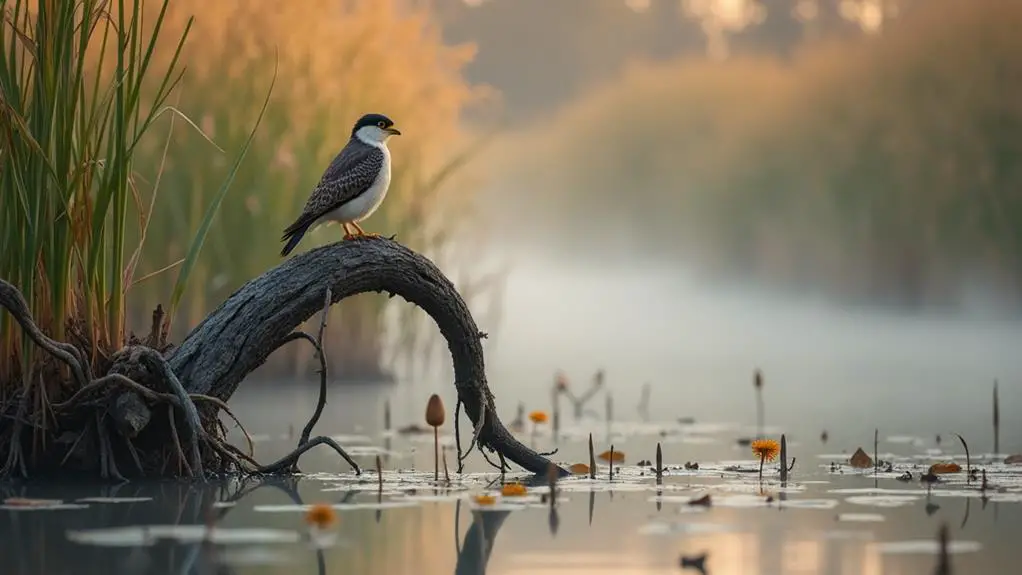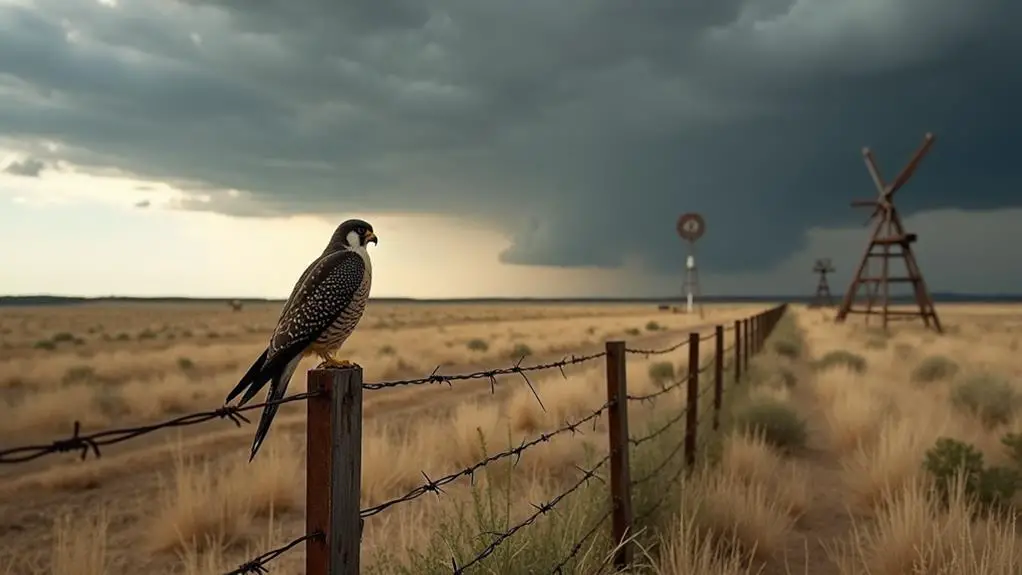As you venture into the vast Texas landscape, you'll likely catch a glimpse of two iconic falcon species: the American Kestrel and the Peregrine Falcon. You might be surprised to learn that these birds of prey have adapted to thrive in diverse environments, from urban skyscrapers to rural wetlands. But what drives their success in this vast state? Do their unique characteristics, like the American Kestrel's blistering speed or the Peregrine Falcon's remarkable adaptability, hold the key to their prosperity? As you explore the world of Texas falcons, you'll uncover fascinating insights into their habitats, behaviors, and survival strategies.
Key Takeaways
- American Kestrels are the smallest yet most common falcon species in North America, found throughout Texas.
- Peregrine Falcons occupy various habitats in Texas, including urban, mountainous, and coastal areas with abundant food sources.
- Texas is home to nearly 30 urban Peregrine Falcon nesting sites, with many featuring custom-built platforms and ideal building architecture.
- The state's coastline provides a distinct habitat range for Peregrine Falcons, with abundant fish-rich waters, shorebirds, and suitable breeding grounds.
- Thousands of falcons congregate in large congregations during spring migration, following specific flyway routes and flock formation patterns.
American Kestrel Species Overview

You're likely familiar with the American Kestrel, the smallest yet most common falcon species in North America.
Found throughout Texas, these birds of prey are a sight to behold. American Kestrels typically range from 9 to 12 inches in length, weighing around 3-6 ounces.
Their brown and gray plumage allows them to blend in with their surroundings, making them expert hunters.
When it comes to Kestrel behavior, these birds are known for their agility and speed.
They can reach speeds of up to 60 mph during dives, making them one of the fastest falcons in North America. Their diet consists mainly of small mammals, insects, and reptiles.
American Kestrels are also cavity-nesting birds, often taking up residence in tree cavities, rock crevices, or even abandoned nests.
Falcon conservation efforts are crucial to protecting the American Kestrel population.
Habitat destruction, pesticide use, and climate change all pose significant threats to these birds.
Peregrine Falcon Habitat Range
You'll find Peregrine Falcons occupying a variety of habitats across Texas, including urban nesting sites where they take advantage of tall buildings and bridges.
They're also drawn to mountainous regions, where cliffs and rocky outcroppings provide suitable nesting and perching sites.
Along the coast, you'll discover Peregrine Falcons exploiting the abundance of prey in these areas, showcasing their adaptability to different environments.
Urban Nesting Sites
Across Texas, nearly 30 cities host peregrine falcon nesting sites, with many of these urban locations boasting multiple nests. You'll find them on skyscrapers, bridges, and other tall structures that mimic their natural cliff-dwelling habitats.
| City | Number of Nests |
|---|---|
| Houston | 10 |
| Dallas | 7 |
| San Antonio | 5 |
| Austin | 4 |
| El Paso | 3 |
These urban nesting sites often feature custom-built nesting platforms, designed to provide a safe and suitable environment for the falcons. Building architecture plays a crucial role in determining the suitability of a nesting site. Tall buildings with ledges, columns, or other features that provide shelter and protection from the elements are ideal. You'll notice that many of these nesting sites are located in close proximity to major highways, rivers, or other areas with abundant food sources. This proximity is critical for the falcons' survival, as they rely on a steady supply of prey to feed themselves and their young.
Mountainous Regions Found
Beyond the urban landscapes, peregrine falcons also inhabit Texas' mountainous regions, where rugged terrain and diverse elevations create a unique habitat range.
As you explore these areas, you'll find that peregrine falcons thrive in the harsh yet majestic environment.
- Rocky outcrops: Peregrine falcons often nest on cliff faces, taking advantage of the natural protection and scenic views.
- Hilltop territories: Falcons claim hilltops as their own, using the elevated vantage points to scan for prey and survey their surroundings.
- Isolated canyons: The peregrine falcon's agility allows them to navigate narrow canyons and gorges, where they can hunt and roost undisturbed.
- Elevated ridges: Falcons perch on ridges, using the wind currents to soar and glide with ease, conserving energy as they scan for potential prey.
In these mountainous regions, peregrine falcons have adapted to the unique challenges and opportunities, making them well-suited to their environment.
Coastal Areas Occupied
Along the Gulf Coast and bays, peregrine falcons occupy a distinct habitat range, exploiting the unique conditions and resources found in these coastal areas. As you explore these regions, you'll notice the falcons' affinity for specific locations. They thrive in areas with abundant food sources, such as fish-rich waters and shorebirds.
| Location | Habitat Feature | Importance |
|---|---|---|
| Gulf Coast beaches | Sandy shores, dunes | Nesting sites, hunting grounds |
| Bay shores | Mudflats, salt marshes | Foraging areas, shelter |
| Estuaries | Brackish waters, mangroves | Food sources, breeding grounds |
| Coastal cities | Skyscrapers, bridges | Perching sites, hunting vantage points |
| Barrier islands | Undeveloped beaches, dunes | Seclusion, protection from human disturbance |
When engaging in coastal birdwatching, you may spot peregrine falcons soaring overhead or perched on beach habitat structures. These areas provide the perfect blend of resources and seclusion, allowing the falcons to thrive in their coastal habitat range.
Texas Falcon Migration Patterns
As you explore Texas falcon migration patterns, you'll notice that spring flock movements typically occur in March and April, with birds traveling in large groups.
Along the Gulf Coast, you'll find that falcons follow specific flyway routes, which can be influenced by food availability and weather conditions.
In the winter, you'll discover that Texas falcons congregate at specific locations, such as coastal wetlands and grasslands, to overwinter.
Spring Flock Movements
During the spring season, many Texas falcons begin their northward migration, with thousands of birds flocking together in large congregations.
As you observe these flocks, you'll notice unique characteristics of their behavior.
You can witness the following aspects of spring flock movements:
- Increased activity: Falcons become more active during spring, with increased flying, hunting, and socializing.
- Flock formation: Large groups of falcons form, often consisting of birds of the same species, but sometimes comprising multiple species.
- Stopover sites: Falcons congregate at specific locations, such as wetlands, lakes, or agricultural fields, to rest and refuel during their migration.
- Altitudinal movements: Falcons are known to migrate at varying altitudes, often flying low over open terrain and rising to higher elevations when crossing mountain ranges.
Coastal Flyway Routes
How do Texas falcons navigate their way through the state's coastline during their migration? They rely on coastal flyway routes, which provide a pathway for these birds to travel along the shoreline.
As you follow their journey, you'll notice that they take advantage of coastal winds, which help them conserve energy and make their trip more efficient. These winds, combined with the falcons' impressive flying skills, allow them to cover long distances with minimal effort.
Along the way, they stop to rest and refuel at shoreline roosts, where they can find food and shelter. These roosts are critical for the falcons' survival, as they provide a safe haven from predators and harsh weather conditions.
As you track the falcons' migration patterns, you'll see that they tend to follow established routes, often flying low over the water or along the beach. This allows them to take advantage of the coastal winds and thermals, which help them soar and glide for long periods.
Wintering Ground Locations
As you explore Texas falcon migration patterns, you'll notice that many Texas falcons spend their winter months in the southern and western parts of the state, where they can find abundant food and suitable habitats.
This region provides ideal wintering grounds, allowing falcons to conserve energy and thrive during the colder months.
When examining wintering habits, you'll observe the following key characteristics:
- Flock dynamics: Falcons often form loose associations with other birds, taking advantage of shared resources and protection.
- Food availability: Wintering grounds offer a reliable source of prey, such as rodents, birds, and reptiles, which are essential for the falcons' survival.
- Habitat diversity: The southern and western regions of Texas provide a mix of open grasslands, shrublands, and urban areas, catering to the falcons' diverse habitat needs.
- Climate: The mild winters in this region allow falcons to conserve energy, as they don't need to expend it to stay warm or find food in harsh environments.
Understanding these wintering ground locations and characteristics is crucial for grasping the overall migration patterns of Texas falcons.
Species Found in Urban Areas
Across Texas's urban landscapes, from skyscraper-lined city centers to suburban neighborhoods, several falcon species have adapted to thrive.
As you explore these areas, you'll notice that urban dwellers like the Peregrine Falcon and the American Kestrel have made these environments their home.
These birds have developed remarkable city adaptations, such as nesting on high-rise buildings and exploiting the abundance of urban prey.
The Peregrine Falcon, in particular, has benefited from the urbanization of Texas.
They've learned to nest on skyscrapers, bridges, and other tall structures, taking advantage of the abundance of ledges and crevices.
This adaptation has allowed them to thrive in areas with limited natural nesting sites.
Meanwhile, the American Kestrel has adapted to the urban environment by exploiting the abundance of rodents and insects in urban areas.
Falcons in Texas Wetlands

Texas's wetland ecosystems, comprising marshes, swamps, and coastal prairies, provide a unique habitat for falcon species that differ from their urban counterparts.
You'll find these birds of prey thriving in wetland habitats, where they've adapted to exploit the abundant food sources and sheltered nesting sites.
Some key characteristics of falcons in Texas wetlands:
- Marsh dwellers: Some falcon species, like the American Kestrel, prefer the dense vegetation of marshes, where they can ambush small prey like rodents and snakes.
- Wetland specialists: Falcons like the Peregrine and Merlin have evolved to hunt in wetland areas, using their speed and agility to catch fish and other aquatic prey.
- Nesting in wetlands: Many falcon species, including the American Kestrel and Peregrine, nest in wetland areas, taking advantage of the protection offered by dense vegetation and proximity to food sources.
- Adaptation to wetland conditions: Falcons in Texas wetlands have developed unique adaptations to survive in these environments, such as specialized feathers and hunting strategies that enable them to thrive in these areas.
Prairie Falcon Hunting Strategies
You'll notice a distinct shift in hunting strategies when moving from wetland falcons to Prairie Falcons, which dominate the open expanses of Texas prairies.
Prairie Falcons have adapted to the vast, open spaces of the prairies, leveraging their exceptional speed to chase down prey. Their hunting tactics involve swift, aerial pursuits, often reaching speeds of up to 40 mph.
When hunting, Prairie Falcons typically employ a "stooping" technique, where they dive at high velocities, folding their wings to minimize air resistance.
This allows them to cover great distances quickly, making it difficult for prey to evade capture. Their exceptional agility and quick reflexes also enable them to make sharp turns and changes in direction, further increasing their hunting success.
In contrast to wetland falcons, Prairie Falcons rarely use ambush tactics or rely on stealth. Instead, they rely on their speed, agility, and exceptional eyesight to track and capture prey in the open prairies.
Rare and Endangered Species

Throughout the vast expanse of Texas prairies, several falcon species are listed as rare or endangered, prompting conservation efforts to protect these magnificent birds of prey.
You might be surprised to learn that human activities, such as habitat destruction, pollution, and climate change, contribute significantly to the decline of these species.
As you delve into the world of falcon conservation, you'll discover that:
- Peregrine Falcons were once listed as endangered due to pesticide poisoning, but conservation efforts have led to their recovery.
- Aplomado Falcons are still critically endangered, with only a few pairs remaining in the wild.
- The Gyrfalcon population is declining due to habitat loss and fragmentation.
- American Kestrels are experiencing a decline in populations, possibly linked to pesticide use and habitat degradation.
Conservation efforts, such as species protection and habitat preservation, are crucial to ensure the survival of these magnificent birds.
Frequently Asked Questions
Can Falcons Be Kept as Pets in Texas?
You can't keep falcons as pets without meeting specific permit requirements; in Texas, only licensed falconers and permitted rehabilitators can legally own these birds, ensuring their welfare and conservation.
Do Falcons Make Good Birdwatching Targets for Beginners?
As you scan the horizon, a majestic silhouette soars into view, like a brushstroke on the sky. You'll find falcons make ideal birdwatching targets for beginners, offering easy spotting and fascinating bird behavior to observe, such as swift dives and aerial acrobatics.
Can Falcons Be Attracted to Backyard Bird Feeders?
You won't typically attract falcons to backyard bird feeders, as they primarily hunt live prey in open spaces, avoiding nesting habitats and urban landscapes where feeders are often located.
How Do Falcons Protect Themselves From Extreme Weather?
You observe that falcons, like other birds, protect themselves from extreme weather by utilizing weather radar to detect approaching storms, seeking shelter in storm shelters or natural cavities, and adjusting their behavior to conserve energy and ride out the harsh conditions.
Are Falcons Considered a Nuisance by Farmers and Ranchers?
You find that birds of prey, like falcons, are often viewed as both friends and foes by farmers and ranchers, as they provide crop protection from rodents, yet sometimes threaten livestock, necessitating wildlife management strategies.
Conclusion
You might think that Texas's urban landscape is inhospitable to falcons, but that's not the case. In reality, these birds of prey have adapted remarkably well to the state's diverse environments. From the American Kestrel's agility in open skies to the Peregrine Falcon's versatility in nesting sites, Texas provides a unique haven for these species. By understanding their habits and habitats, you can better appreciate the fascinating world of Texas falcons and work to preserve their place in the Lone Star State's ecosystem.





